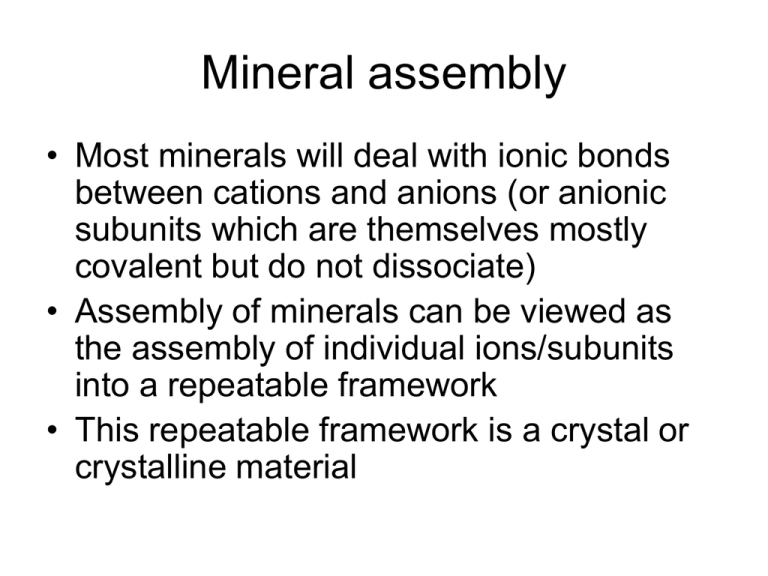Mineral assembly
advertisement

Mineral assembly • Most minerals will deal with ionic bonds between cations and anions (or anionic subunits which are themselves mostly covalent but do not dissociate) • Assembly of minerals can be viewed as the assembly of individual ions/subunits into a repeatable framework • This repeatable framework is a crystal or crystalline material Mineral Assembly • Isotropic – same properties in every direction • Anisotropic- different properties in different directions most minerals are this type • Assembly of ions from melts, water, or replacement reactions which form bonds • The matrices the ions are in always contain many different ions – different conditions of formation for the same mineral creates differences… Polymorphs • Two minerals with the same chemical formula but different chemical structures • What can cause these transitions?? •sphalerite-wurtzite •pyrite-marcasite •calcite-aragonite •Quartz forms (10) •diamond-graphite Complexes Minerals • Metals in solution are coordinated with ligands (Such as H2O, Cl-, etc.) • Formation of a sulfide mineral requires direct bonding between metals and sulfide – requires displacement of these ligands and deprotonation of the sulfide • Cluster development is the result of these requirements Mineral growth • Ions come together in a crystal – charge is balanced across the whole • How do we get large crystals?? – Different mechanisms for the growth of particular minerals – All a balance of kinetics (how fast) and thermodynamics (most stable) Nucleation • Aggregation of molecules builds larger and larger molecules – becomes a nucleus at some point • Nucleus – size of this is either big enough to continue growth or will re-dissolve (Critical Size) • Overall rate of nucleus formation vs. crystal growth determines crystal size/distribution Crystal Shapes • Shape is determined by atomic arrangements • Some directions grow faster than others • Morphology can be distinct for the conditions and speed of mineral nucleation/growth (and growth along specific axes) Ostwald Ripening Larger crystals are more stable than smaller crystals – the energy of a system will naturally trend towards the formation of larger crystals at the expense of smaller ones In a sense, the smaller crystals are ‘feeding’ the larger ones through a series of dissolution and precipitation reactions Figure 3-17. “Ostwald ripening” in a monomineralic material. Grain boundaries with significant negative curvature (concave inward) migrate toward their center of curvature, thus eliminating smaller grains and establishing a uniformly coarse-grained equilibrium texture with 120o grain intersections (polygonal mosaic). © John Winter and Prentice Hall Small crystals… • In the absence of ripening, get a lot of very small crystals forming and no larger crystals. • This results in a more massive arrangement • Microcrystalline examples (Chert) • Massive deposits (common in ore deposits) Topotactic Alignment •Alignment of smaller grains in space – due to magnetic attraction, alignment due to biological activity (some microbes make a compass with certain minerals), or chemical/ structural alignment – aka oriented attachment Igneous Textures Figure 3-1. Idealized rates of crystal nucleation and growth as a function of temperature below the melting point. Slow cooling results in only minor undercooling (Ta), so that rapid growth and slow nucleation produce fewer coarse-grained crystals. Rapid cooling permits more undercooling (Tb), so that slower growth and rapid nucleation produce many finegrained crystals. Very rapid cooling involves little if any nucleation or growth (Tc) producing a glass.



